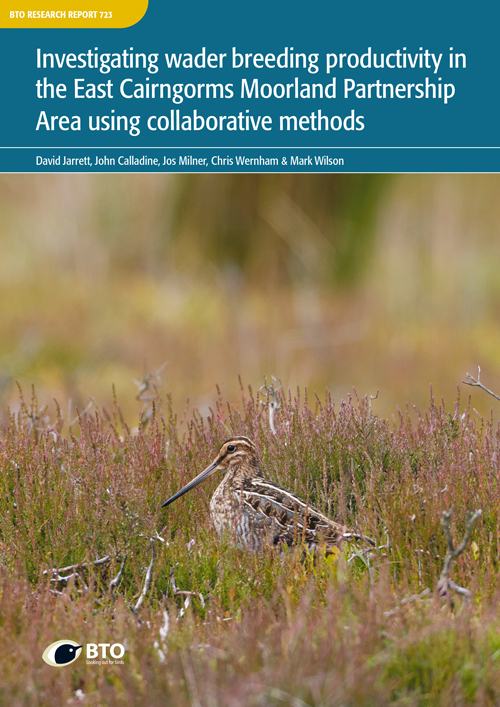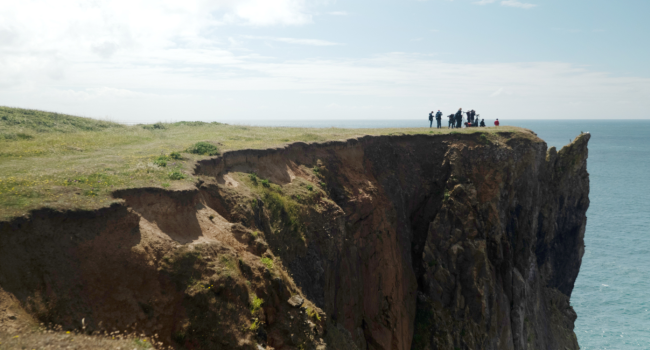Investigating wader breeding productivity in the East Cairngorms Moorland Partnership Area using collaborative methods
Author(s): Jarrett, D., Calladine, J., Milner, J., Wernham C. & Wilson, M.
Published: December 2019 Issue No.: 723 Pages: 36pp
ISBN: 978-1-912642-11-3
Download article 4.58 MB application/pdf
Abstract
1. Breeding wader populations in Britain have declined markedly in recent decades. During this time, areas of moorland managed for grouse shooting and adjacent areas of rough pasture have been identified as persisting strongholds. Targets for forest expansion across Scotland can deliver conservation gains for woodland biodiversity and other environmental benefits but, in some areas, could also potentially further constrain breeding waders. Land management planning in the Cairngorms National Park (CNP) requires a balance between these and other competing objectives. Improved knowledge on the distribution, trends and breeding success of waders and the constraints they experience will help achieve a balance to the benefit of competing objectives.
2. This report describes two years (2018–19) of a project carried out collaboratively with the East Cairngorms Moorland Partnership (ECMP), which comprises six estates (Mar Lodge, Mar, Invercauld, Balmoral, Glenavon and Glenlivet) and the Cairngorms National Park Authority. The over-arching purpose of the partnership is to demonstrate a clear contribution to the aims of the CNP, including priority species conservation through sustainable moorland management. These estates contain a mix of farmland, woodland, moorland and montane habitat, with objectives including management for driven grouse shooting, deer stalking and woodland expansion. Predator control associated with management for grouse shooting is carried out across much of the partnership area.
3. Aims of the project included assessing how to increase the robustness of analyses, investigating associations of landscape configuration (notably woodland cover) and other covariates on wader breeding success, and to further consider possible strategies for ongoing monitoring of breeding wades.
4. A BTO staff member and ECMP project officer worked with estate staff (gamekeepers, rangers and ecologists) across the East Cairngorms Moorland Partnership (ECMP) area to train and encourage staff to monitor breeding waders using a variety of field methods. All project data were gathered by estate staff and a wildlife volunteer group.
5. Estate staff returned breeding wader transect survey data from 16 sites in 2018 and 17 sites in 2019 within the ECMP area, carrying out two or three survey visits at each site. There was variation in the sites covered (nine were covered in both years), with 156 apparent wader territories (ATs) identified in 2018, and 179 ATs in 2019. In 2019 Lapwing Vanellus vanellus (75 ATs), Oystercatcher Haematopus ostralegus (44 ATs), and Curlew Numenius arquata (45 ATs) were the most frequently recorded species.
6. A productivity index based on behaviour indicating breeding success from second or third visits on the transect surveys gives estimated proportions of pairs retaining young as 75% for Curlew, 69% for Lapwing, and 63% for Oystercatcher across both years of data, with lower productivity estimated in 2019 for each species. There was no apparent difference hatching success between years, suggesting the difference was likely due to higher chick mortality in 2019.
7. Across two years of the project, estate staff located and monitored 183 wader nests using temperature data loggers, with Lapwing (102), Oystercatcher (59) and Curlew (17) the most commonly monitored species. Hatching success of 54% for Lapwing, 65% for Oystercatcher and 75% for Curlew across the study area was estimated using the standard ‘Mayfield method’.
8. Fifty-nine nests were also monitored with trail cameras over the two years, with the following nest predators identified: Common Gull Larus canus (two nests), Jackdaw Corvus monedula (one nest), Stoat Mustela erminea (three nests), Pine Marten Martes martes (three nests), Badger Meles meles (one nest), Sheep Ovis aries (one nest). Sheep were also recorded trampling one nest.
9. Participants demonstrated the ability to find and monitor Curlew nests in the second year of the project with 15 nests found and monitored (compared with two in the first year). Curlew are a high conservation priority, classed as ‘near threatened’ by the IUCN, and nests are challenging to find. In 2017 (the most recent year that data is available) data from only 16 Curlew nests were submitted to the BTO’s Nest Record Scheme across the whole of Scotland.
10. Mixed models were not able to detect a significant effect of woodland cover on hatching success at any of a range of spatial scales. Power analysis suggests that we should be able to detect effects which change hatching success by 19% or greater with the sample size of nests monitored over two years. However the power to detect variation within the sampled nests, for example associated with proximity to woodland cover, was weaker.
11. Assessing wader breeding success from observations of adult behaviour showed a close match to measures determined more directly. This approach deserves further development as a cost effective means to assess breeding success and ultimately associations with landscape configuration.
12. Participating staff have committed significant time and resources to gathering data, while also demonstrating excellent field-craft and knowledge of wader species. Training estate staff in upland areas would prove an effective means of adding to the data needed to improve our understanding of wader breeding productivity across a range of landscapes.
Notes
This work was funded by the Cairngorms National Park Authority. We are grateful for the efforts of staff at the following estates who carried out fieldwork for the project: Balmoral, Glenavon, Glenlivet, Invercauld, Mar, Mar Lodge and Rhiedorrach. Volunteers from the Tomintoul and Glenlivet Wildlife Group also contributed to some fieldwork and data collation.









Share this page